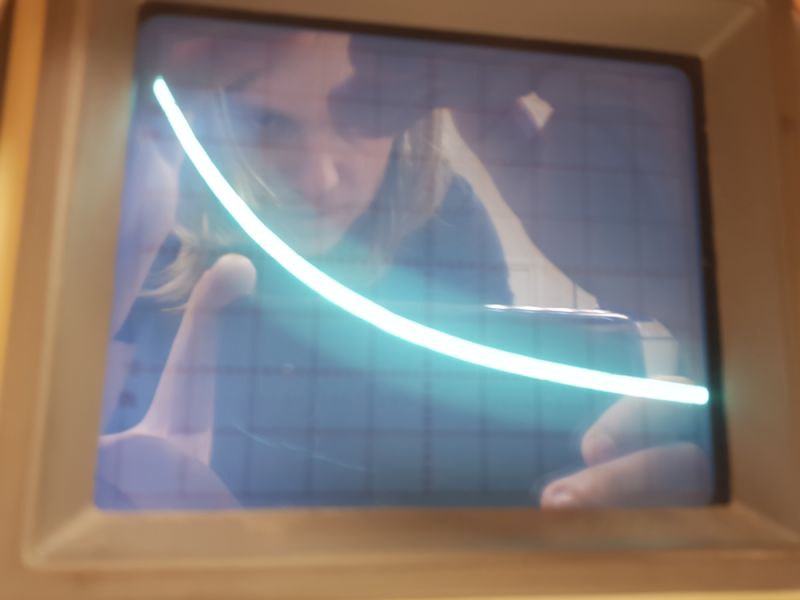Join devRant
Do all the things like
++ or -- rants, post your own rants, comment on others' rants and build your customized dev avatar
Sign Up
Pipeless API

From the creators of devRant, Pipeless lets you power real-time personalized recommendations and activity feeds using a simple API
Learn More
Search - "analogue"
-
Today at school I borrowed an oscilloscope and a few capacitors and used a circuit I made at home to just demonstrate the discharge of a capacitor, since my physics teacher asked me to teach the class about this on Friday
So it's one of those old analogue scopes, so to get a nice line I turned the speed right down and did a long exposure shot with my phone and it turned out brilliantly! 31
31 -
My first hack... Back at the days when phones had disks to dial a number. I was a kid of cause, I'm not that old. I used to like to call my grans. Once, when I supposed to go to sleep already, I've found out that there is phone socket in my room (the one connected to the copper wire, that is where the word "phone line" came from).
It took me about a half of an hour to detach handset from the toy phone and about two ours to reverse engineer dialing protocol (you just need to disconnect the line sequentially corresponding number if times).
And after that I've heard my granny's voice. I was literally overwhelmed that it worked.6 -
All I want is a another DVI cable so I can connect my secondary monitor digitally instead of by VGA. From their reaction, you could think I had instead asked for a gold-plated desk. Was it really nescessary to have three guys check (non-technical people, too) if *they* could see a difference between my monitors? My primary one is DVI, and *I* can see that the monitor connected by VGA is blurrier. Who connects a flat panel monitor by VGA anyway? Just the idea of an unnescessary pair of analogue-to-digital/digital-to-analogue conveters in the middle of what should be a straight digital connection should be an affront to any sensible technical person. So of course, no extra DVI cable for me.
Call me stupid, but I think it has probably cost the company more money from lost productivity having three people look at my monitors instead of just buying me another DVI cable like I asked for nicely.2 -
What you are expected to learn in 3 years:
power electronics,
analogue signal,
digital signal processing,
VDHL development,
VLSI debelopment,
antenna design,
optical communication,
networking,
digital storage,
electromagnetic,
ARM ISA,
x86 ISA,
signal and control system,
robotics,
computer vision,
NLP, data algorithm,
Java, C++, Python,
javascript frameworks,
ASP.NET web development,
cloud computing,
computer security ,
Information coding,
ethical hacking,
statistics,
machine learning,
data mining,
data analysis,
cloud computing,
Matlab,
Android app development,
IOS app development,
Computer architecture,
Computer network,
discrete structure,
3D game development,
operating system,
introduction to DevOps,
how-to -fix- computer,
system administration,
Project of being entrepreneur,
and 24 random unrelated subjects of your choices
This is a major called "computer engineering"4 -
Can you spot the difference?
So after getting the 37 sensor arduino module kit, i decided to label each of them. The 2 modules below are the last 2 in need of labeling...
One is a magnetic hall and the other is an analogue hall but I can't tell which is which. Googling just makes it worse since they are so similar the same image is often used for both modules. The only visible difference is one has a small resistor and what appears to be a tiny led.
Please help me identify them... asking for a friend. 15
15 -
Im thinking about getting a raspberry pi 3 or an odroid-c2.
(Specs at the end)
Its to host a simple php server and maybe a gitlab server, both for personal use.
Should I go with the better performance or the better community support?
Odroid specs
System-on-chip used : Amlogic S905
CPU: 1.5 GHz 64-bit quad-core ARM Cortex-A53
Memory: 2 GB LPDDR3 RAM at 912 MHz
Storage: MicroSDHC slot, eMMC module socket
Graphics: Mali-450 MP3
Connectivity: 4× USB 2.0, micro-USB OTG, HDMI 2.0, Gigabit Ethernet (8P8C), Infrared, 40× GPIO ports
Raspberry specs:
SoC: Broadcom BCM2837
CPU: 4× ARM Cortex-A53, 1.2GHz
GPU: Broadcom VideoCore IV
RAM: 1GB LPDDR2 (900 MHz)
Networking: 10/100 Ethernet, 2.4GHz 802.11n wireless
Bluetooth: Bluetooth 4.1 Classic, Bluetooth Low Energy
Storage: microSD
GPIO: 40-pin header, populated
Ports: HDMI, 3.5mm analogue audio-video jack, 4× USB 2.0, Ethernet, Camera Serial Interface (CSI), Display Serial Interface (DSI)8
